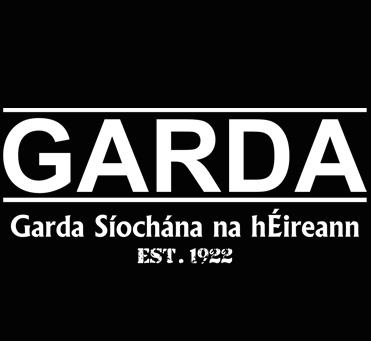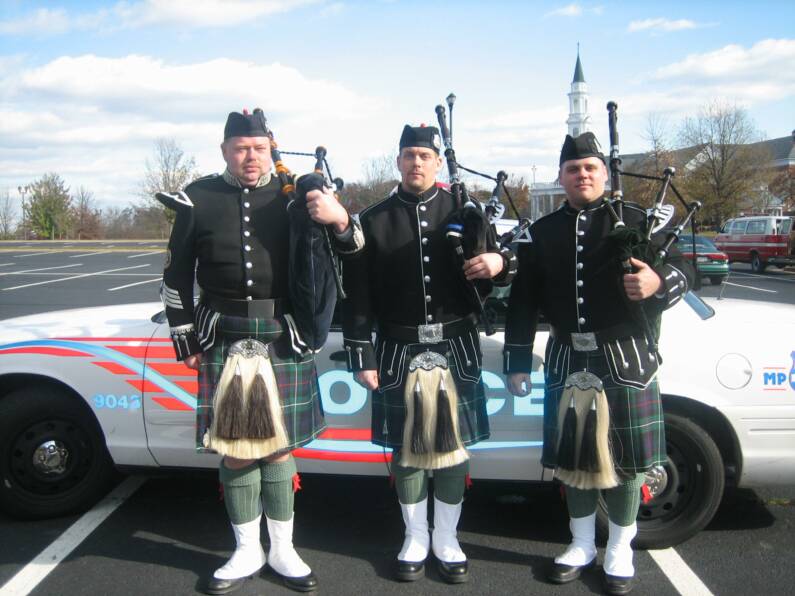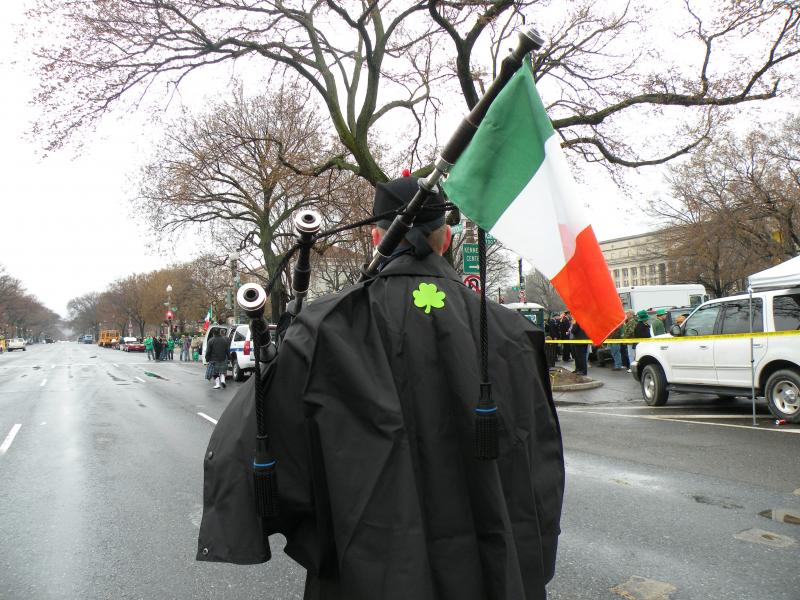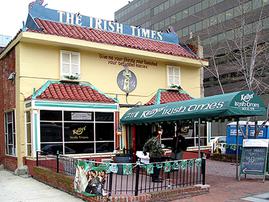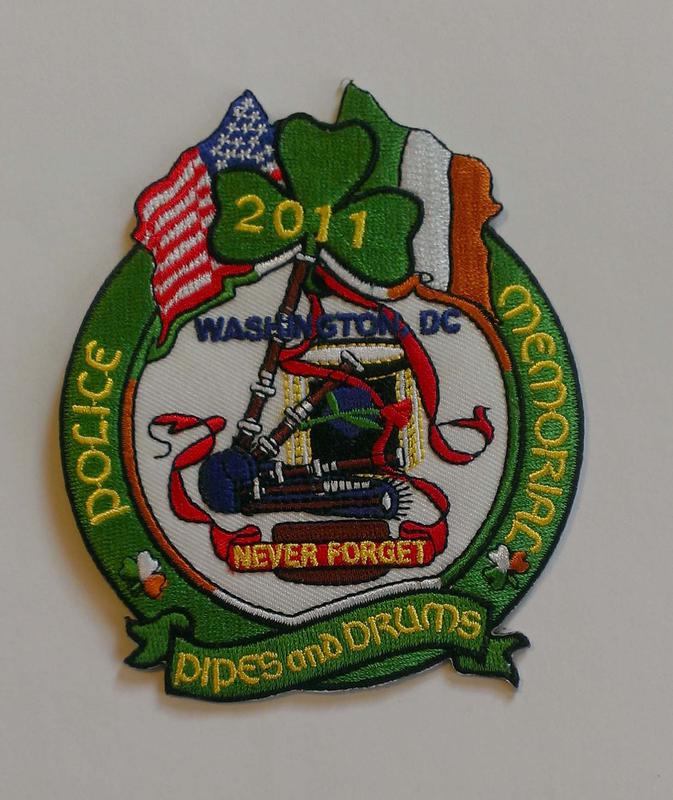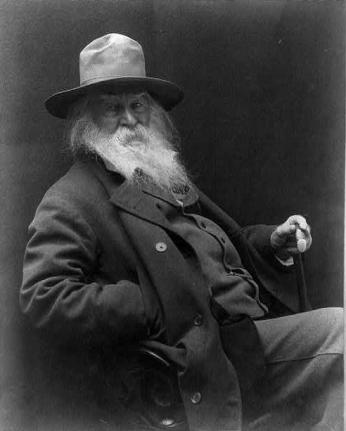Washington D.C. Metropolitan Police
M.P.D.
& Their Irish Heritage
IRISH ITEM OF INTEREST:
This is a photo of a now defunct Franklin Motor Car Company from the first decade of 1900. Most will agree on two possabilities that these transport vehicles were known as paddy wagons. One is the large number of policemen who were of Irish descent and the second was because so many of it's customers were of Irish descent. Personally I believe it's a combination of the two. These specialized trucks were also called Black Marias (pronounced "mariahs"), piewagons, or Mother's Hearts. Mother's Hearts, because, tongue-in-cheek, it was said there was always "room for one more".
As a man of Irish descent, I enjoyed putting this page together. My Grandmother came to America on the RMS Lusitania's last complete voyage across the Atlantic before being sunk, she was only seventeen years old. I recall the family get togethers with Irish music always in the background. When I became a Policeman in the mid 80's many of the Irish traditions were still a daily part of the police community. Over the past twenty years they seemed to have dwindled away as the new mindset of policing has taken a front. Fortunately some of the traditions will always be with us.
PIPES and DRUMS and so much more have been a part of the Police community since we began policing in America. Today they are mostly seen at Police funerals or formal ceremonies. They represent several historical monuments of Irishman in the beginning of police departments across America. American cities are where this was most noticeable Irish were, however it was not restricted to just cities. Where I work in Foxboro Mass. the first police Chief was Irish so the Irish employees at a local hat factory could be better dealt with when needed.
Click tab below to visit "D.C. Police Pipes and Drums" Web site
IRISH POLICEMAN OF INTEREST:
Maurice J. Cullinane served as the Police Chief for the Washington D.C. Police from December 1974 thru January 1978. He is best known for the photo below and for becoming one of the agencies Chief of Police
Today many people think the Irish just walked into great jobs and had everything handed to them. Years ago there were two types of Irish. Those born here known as the American Irish and those who came to America from Ireland known simply as The Irish. Those coming from across the pond were not always wanted here. Signs in side store windows with IRISH NEED NOT APPLY would not be uncommon.
Having said that the VOTE was always an important part of a community and so when a politician needed votes he might provide jobs for the votes within the municipalities budget. This could include Police Departments and fire departments among other city/town positions with political influence. If
Below is an example of how the media would show their negative view of the Irish and of the Irish Police
Washington D.C. Police in the early 1920's
 | ||||||
 | ||||||
 | ||||||
The Cullinane surname is an Anglicization of the Irish Gaelic "O' Cuilleannain".
 | ||||||
Washington D.C. Metropolitan Police Honor Guard flanked by the D.C. Police Pipes and Drums
IRISH POLICEMAN OF INTEREST:
Sgt Cahil is shown here inspecting cadtes at the Police Academy. Sgt Cahil was described to me as being an old school cop who didn't have a mean bone in his body.
Hey I am from Massachusetts, so....
I had a memorable time here a few years ago. As I sat here with brothers I heard from the distance the sound of Ireland. As time passed it got closer and closer. The next thing I know there was aPolice Pipe and Drums Unit proudly playing as they presented themselves to the crowd.
BlackSheep Productions 2009
MORE OF THE PIPES AND DRUMS FROM D.C.
DC Police Pipes and Drums
'In Onoraigh Ar Marbh'
"We Honor Our Fallen"
With the folks of Ireland being the first large group of immigrants to enter the new world of policing it was on natural that the pipes and drums should become a police tradition. One hundred and fifty years after the birth of the Washington D.C. Metropolitan Police the tradition is still going strong...
 | ||||||
 | ||||||
 | ||||||
 | ||||||
 | ||||||
 | ||||||
 | ||||||
 | ||||||
 | ||||||
 | ||||||
 | ||||||
 | ||||||
 | ||||||
 | ||||||
IRISH POLICE PATCHES
 | ||||||
Although all of the patches below are not shown yet I have all from 2000 thru 2016
Who was Saint Patrick
and
What is the History of St. Patrick's Day?
Story by Seth Andrea McCoy: A brief history of the holiday includes paganism, Christianity and 'snakes'.
Happy St. Patrick’s Day to you! Today is the day that the Irish wait for every year – and the day that the non-Irish become Irish for 24 hours.
Or, if you’re like me with an Irish last name but hardly any Irish in you, it’s the day you politely tell people that you aren’t wicked excited that it’s St. Patrick’s Day. No offense to those of you who are Irish through and through, or wish you were Irish on March 17.
So what is St. Patrick’s Day all about anyway and why do we celebrate it? Well, according to various sources on the internet, St. Patrick was born in Wales around AD 385. Before becoming St. Patrick he answered to the name Maewyn and, until turning 16, he identified himself as a pagan (no real shocker there, as most people back in those days were pagan). It wasn’t until he was kidnapped by Irish marauders and held as a slave for six years that he turned to God.
After his escape from slavery he went to Gaul and studied in the monastery for 12 years. It was during this time that he came to believe that he must convert pagans to Christianity. For 30 years he traveled through Ireland establishing monasteries and successfully converting pagans to Christianity before dying on March 17 in AD 461.
As I’ve mentioned before, many of our current holidays have their origins in paganism. St. Patrick’s Day is no different, albeit this holiday came about because a former pagan turned to Christianity and in turn worked to convert the people of Ireland to the Church.
There is much folklore about St. Patrick and what he did as he traveled around Ireland converting the pagans. One of these is that he drove the snakes from Ireland. That should not be taken literally, for “snakes” refers to the pagans that he converted to Christianity. Snakes, for those who may not be aware, are symbolic for pagans and if you see someone wearing a snake pin or other piece of snake jewelry on March 17 chances are they are pagan.
He also used the three-leaved clover in his travels as a tool to teach the Irish about the Trinity. Each of the three clover leaves, he would explain, represented the Father, the Son and the Holy Spirit. The shamrock was adopted as a symbol of St. Patrick’s Day as a result. Of course there are other symbols of this day including the leprechaun and wearing green, for example.
And did you know that up until 1737, St. Patrick’s Day wasn’t celebrated in the United States? That is until our fair city held the first public celebration of St. Patrick. Yup, that’s right, Boston brought St. Patrick’s Day to America. Of course these days most every major city – and some smaller ones – celebrates St. Patrick’s Day with parades and/or other events.
So on this St. Patrick’s Day (and during the weekend festivities) when you’re out and about wearing your “Kiss Me I’m Irish” t-shirt and drinking green beer may the luck of the Irish be with you. Please remember to be safe out there and make sure that if you’re drinking you have a designated driver to get you home.
About this column: Seth Andrea McCoy is a West Roxbury resident who hosts 'All About Boston' on BNN, is a vegan, and has plenty of opinions to offer.
 | ||||||
National night out, 2011
M.P.D.'s Irish Police
Please send me your Irish stories related to the MPDC. We can not forget our past...
Tiarna linn go tú ag féachaint síos ar do póilíní le bhfabhar
Lord we ask that you look down on your police with favor
FAMILY !
THE PIPES
THE TIN PIPE
THE IRISH DRUM
Pipers Jeff Maslona and Chris Ritchie at St. Patricks in NW helping out a brother officer at his wedding...
M.P.D. Officer William Tinsley and Bullet
William Tinsley was born in 1936 in the formerly Irish neighborhood known as Swampoodle, which was between G and K Streets, to either side of North Capital. As a boy Tinsley shined the shoes of servicemen arriving at Union Station during World War II.
Tinsley’s fondest memories of his career in the Metropolitan Police are those of the dog he trained and patrolled with, and to this day he has a picture of Bullet –– who once saved his life from hatchet-wielding burglar –– in his living room.
For a number of years Officer Tinsley and Bullet toured Washington, appearing at recreation centers all over the city, at half-time in RFK Stadium, and on the Maury Povich television show, to demonstrate Bullet’s training, but also his gentle character, to counter public misperception of the nature of police dogs. Wherever they went, Tinley readily admits, Bullet was the star of the show.
Officer Tinsley ended his career in Washington in charge of the tactical division of the 2nd District. In 1980, at age 44, he became animal control officer in the Stafford County Sheriff’s Department, from which he has now retired, after a total of 42 years in law enforcement.
 | ||||||
An Irish Policeman, a Toddler and Walt Whitman
In 1871, the city of Washington was taken up in a scandal of police brutality, perhaps one of the earliest in the city. At the center of the storm was an Irish policeman, a toddler, and Walt Whitman.
Getting to Walt Whitman later, the policeman was Francis Michael Doyle, born in Limerick, Ireland in 1833. He immigrated to the US with his family in the 1850s, married a Marylander in 1858, and fought for the Union during the Civil War. In 1868, he joined the DC police and was serving as a private in the 6th precinct when Joseph Burnham asked the police to put a warrant out for the arrest of John Murete-let. Burnham was a well-to-do local businessman. Murete-let was a three-year-old.
Burnham had called for the boy to be arrested over $3 ($50+ today) worth of stolen eggs. This Scrooge had apparently already procured $2 from Murete-let’s mother in order to forgo an arrest, but swore out the warrant anyway. Private Doyle was sent to the child’s home to serve the warrant and had to get the poor boy out of bed in order to arrest him. Doyle carried little Murete-let down to the station wrapped in a cloak, where other officers let the child go back to sleep.
When the papers got ahold of this mess, they did not mince words:
The Police Annals, in any city, does not present a case of greater outrage upon humanity and decency, or a more perfect burlesque upon justice, than that of the arrest and incarceration of a child… -- The Critic
…[The police’s] conceit of office has robbed them of what little brains and judgement they possessed, and reduced them to mere automatons, fit only to work in ruts and grooves as they are ordered, and not fit to hold any position in which as much tact and knowledge of human nature is required as that of police officer. -The Daily National Republican
Some threw out the stirring speeches and cut to the chase with scathing sarcasm:
The brave Officer Doyle valiantly arrests a baby for stealing eggs. -- Daily Patriot
The outrage in the city was palpable as citizens called for Doyle’s dismissal, or for Doyle to be brought up on charges himself. The judge assigned to the case against Murete-let agreed, and dismissed the egg-stealing charges while the Board of Police called Doyle to explain his actions. Doyle explained that he had had doubts about serving the warrant, but on the advice of his fellows did his duty. He had thought the boy was seven years old and a “fit subject for the reform school."[1]
We’ll let The Daily Chronicle tell you what the Board decided:
Private F.M. Doyle, for conduct unbecoming an officer, Christian, gentleman, man, or human being, either savage, civilized, or enlightened, was simply ‘severely reprimanded.’ This extreme punishment consisted of reading a half-sheet of notepaper over so that he could hear it
Enter Walt Whitman, treasured national poet and journalist of the 19th century. Whitman was in a relationship with the private’s brother, Peter Doyle, and like any good boyfriend, did what he could to help his bae’s bro. He drafted an article in support of Private Doyle, but it went unpublished as his mechanisms behind the scene showed promise. The newspapers shifted their vitriol away from Doyle and towards Burnham (described as “a mercenary and inhuman brute”), and in a few weeks the scandal had largely faded from the public consciousness.[2]
As for Doyle, he was dead within the year, murdered on the beat by the Queen of Louse Alley.[3] It’s unclear what happened to young Murete-let, but a romantic mind may imagine that he grew up with further incident or run-ins with the law and settled down as something respectable. A chicken farmer, perhaps.
Sources:
Krieg, Joann P. Whitman and the Irish. (University of Iowa Press, 2000).
Murray, Martin G. “Whitman Takes on D.C.’s Dailies.” The Yale University Library Gazette, (October 1995): 47-57.
“Officer Francis M. Doyle.” Officer Down Memorial Page.
Peck, Garrett. Walt Whitman in Washington, D.C.: The Civil War and America’s Great Poet. (History Press, 2015).
“Died – Doyle.” Evening star. (Washington, D.C.), 30 Dec. 1871. Chronicling America: Historic American Newspapers. Lib. of Congress.
Whitman, Walt. The Correspondence: Volume II, 1868-1875. Ed. Edwin H. Miller. (NYU Press, 2007).
Walt Whitman -- whose boyfriend, Peter, was Officer Doyle's brother -- came to the policeman's defense as the outrage over the case intensified. (Source: Library of Congress)
Metropolitan Police officer Francis M. Doyle found himself in hot water when he arrested a 3-year-old in Washington in 1871. (Photo source: Officer Down Memorial Page website)
ESTABLISHMENT OF EMERALD SOCIETIES
Complied By: Patrick F. O’Brien
1950’s
New York City Police Department Emerald Society 1953
New York City Department of Correction Emerald Society 1955
New York City Fire Department Emerald Society 1956
New York City Transit Police Emerald Society 1956
Emerald Society of New York Post Office (Origin 1939) * 1957
New York City Housing Authority Police Emerald Society 1958
Essex County Police & Fire Emerald Society (NJ) 1958
New York City Housing Employees Emerald Society * 1958
1960’s
Emerald Society of New York City Transit Authority * 1961
Consolidated Edison Emerald Society of New York * 1962
Port Authority Police Emerald Society (NY & NJ) 1965
Suffolk County Police Emerald Society (NY) 1967
Jersey City Police Emerald Society (NJ) 1968
Nassau County Police Emerald Society (NY) 1968
Westchester Police Emerald Society (NY) 1968
Emerald Society-Telephone & Communications Workers * 1969
New York City Department of Education Emerald Society * 1969
1970s
Boston Police Emerald Society (MA) 1971
Rockland County Police Emerald Society (NY) 1972
Philadelphia Emerald Society (PA) 1973
Emerald Society of Illinois 1975
Grand Council of United Emerald Societies (Origin 1956) * 1975
New Haven Police Emerald Society (CT) 1979
Emerald Society Firefighters of Washington DC 1979
1980s
Firefighters Emerald Society of Westchester County (NY) 1980
Union County Police and Fire Emerald Society (NJ) 1981
Rhode Island Police officers Emerald Society (RI) 1982
West Haven Police Emerald Society (CT) 1982
Cape May County Police & Fire Emerald Society (NJ) 1984
Emerald Society of Morris County (Police & Fire) (NJ) 1985
1990’s
Emerald Society of Delaware (DE) 1990
Nassau County Sheriff’s Department Emerald Society (NY) 1990
Emerald Society of Wisconsin (WI) 1990
Emerald Society of Columbus Ohio



 1990
1990
Passaic County Police & Fire Emerald Society (NJ) 1991
Los Angeles Police Emerald Society (CA) 1992
Middlesex County Police & Fire (NJ) 1993
Ocean County Police & Fire Emerald Society (NJ) 1993
New Haven County Firefighters Emerald Society (CT) 1993
Camden County Police & Fire Emerald Society (NJ) 1994
New York Drug Enforcement Emerald Society (NY) 1994
Grand Council Police & Fire Emerald Societies of N.J. 1994
Suffolk County Sheriff’s Emerald Society (NY) 1994
Westchester Correction Officers Emerald Society (NY) 1994
Indianapolis Firefighters Emerald Society (MN) 1994
National Conference of Law Enforcement Emerald Societies 1995
Emerald Society of Vermont (VT) 1995
Federal Law Enforcement Agencies Emerald Society 1995
Middletown Police & Fire Emerald Society (NJ) 1995
Monmouth County Police & Fire Emerald Society (NJ) 1995
New York State Court Officers Emerald Society 1995
Wichita Kansas Police Emerald Society (KS) 1995
Baltimore Area Police Emerald Society (MD) 1996
Monroe County Law Enforcement Emerald Society (PA) 1996
Prince Georges County Firefighters Emerald Society (MD) 1997
Emerald Society of Missouri (St. Louis) 1997
Emerald Society of Texas (Austin) 1997
Greater Cleveland Police Emerald Society (OH) 1997
Law Enforcement Emerald Society of South Florida (FL) 1997
Metropolitan Atlanta Police Emerald Society (GA) 1997
Omaha Area Emerald Society (NB) 1997
Pittsburgh Police Emerald Society (PA) 1997
Indiana Emerald Society (IN) 1997
Detroit Metro Police Emerald Society (MI) 1998
Greater Worchester Police Emerald Society (MA) 1998
Heart of America Emerald Society (KS) 1998
San Francisco Bay Area Law Enforcement Emerald Society 1998
Police Emerald Society of Southeast Georgia (Savannah) (GA) 1998
Inland Empire Emerald Society (San Bernardino) (CA) 1998
Jacksonville Area Firefighters Emerald Society (FL) 1998
Fire & Police Emerald Society of Monterey County (CA) 1998
New York State Corrections Emerald Society 1999
Police Emerald Society of the Greater Richmond Area (VA) 1999
Police Emerald Society of Tidewater, Virginia (VA) 1999
Irish-American Police Officers Association, Massachusetts (MA) 1999
San Diego Law Enforcement Emerald Society (CA) 1999
New Hampshire Police Emerald Society (NH) 1999
Capital District Law Enforcement Emerald Society of Upstate NY 1999
Firefighters Emerald Society of Metropolitan Atlanta (GA) 1999
Connecticut State Police Emerald Society (CT) 1999
2000
Northeastern Pennsylvania Emerald Society (PA) 2000
Western Massachusetts Emerald Society (MA) 2000
Colorado Emerald Society (CO) 2000
Gloucester County Emerald Society (NJ) 2000
Police & Fire Emerald Society of Nevada (Las Vegas) (NV) 2000
2001
Law Enforcement Emerald Society of Metro New Orleans (LA) 2001
Chester County Emerald Society (PA) 2001
Bridgeport Police Emerald Society (CT) 2001
2002
Maine Police Emerald Society 2002
Oregon Police Emerald Society 2002
Anne Arundel Firefighters Emerald Society (MD) 2002
2003
Arizona Law Enforcement Emerald Society


 2003
2003
2005
Police Emerald Society of Great Britain (England) 2005
2006
San Jose Police Emerald Society (CA) 2006
Inland Empire Emerald Society (CA) 2006
2009
New York State Troopers Emerald Society 2009
2010
San Diego Firefighters Emerald Society (CA) 2010
2011
Worcester County Fire Fighters Emerald Society (MA) 2011
2012
Orange County Fire Emerald Society (CA) 2012
Police Emerald Society Hudson Valley (NY) 2012
2013
Las Vegas Emerald Society (NV) 2013
2019

Orange County Law Enforcement Emerald Society (CA) 2019
*Non-Public Safety Emerald Society
Author: Patrick O’Brien, NCLEES Historian
UPDATED: 09/28/22





